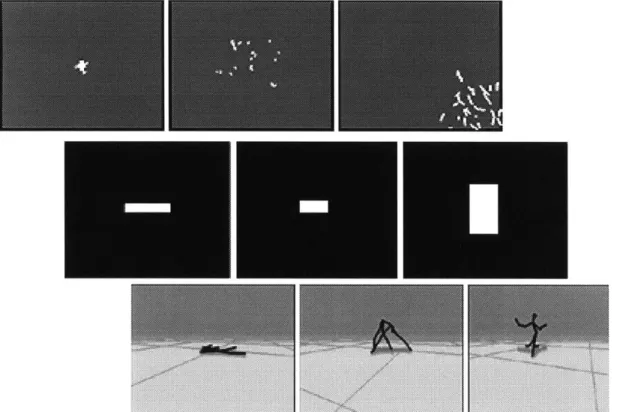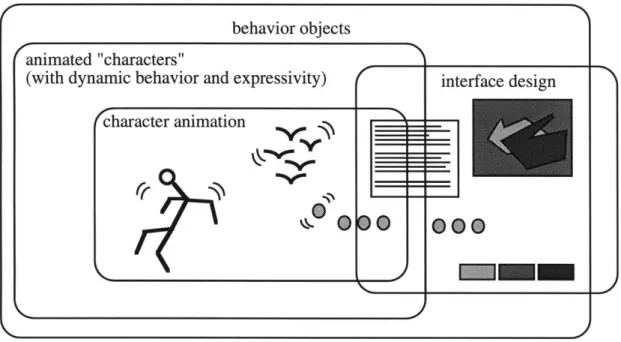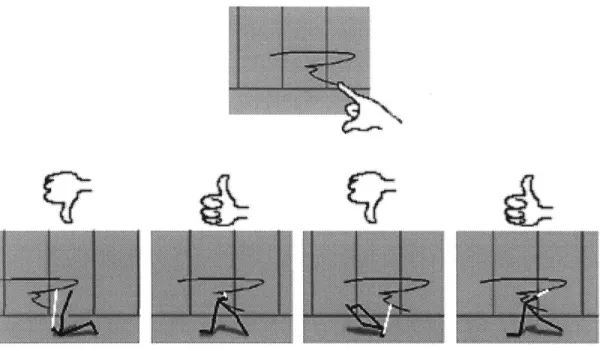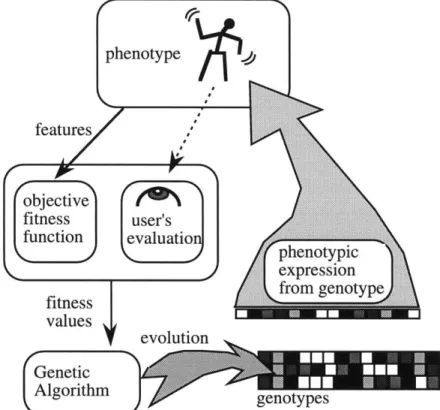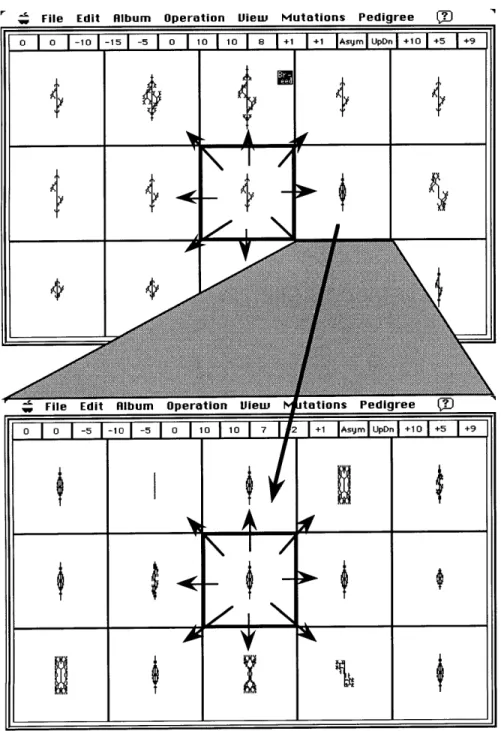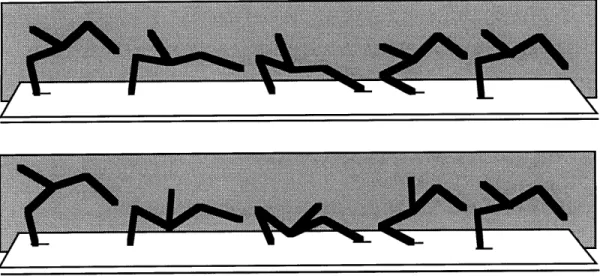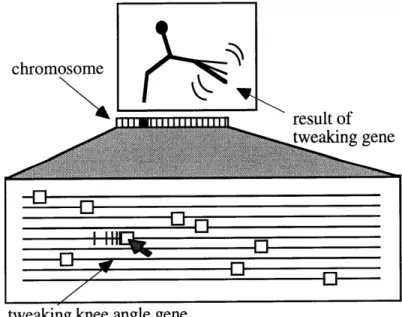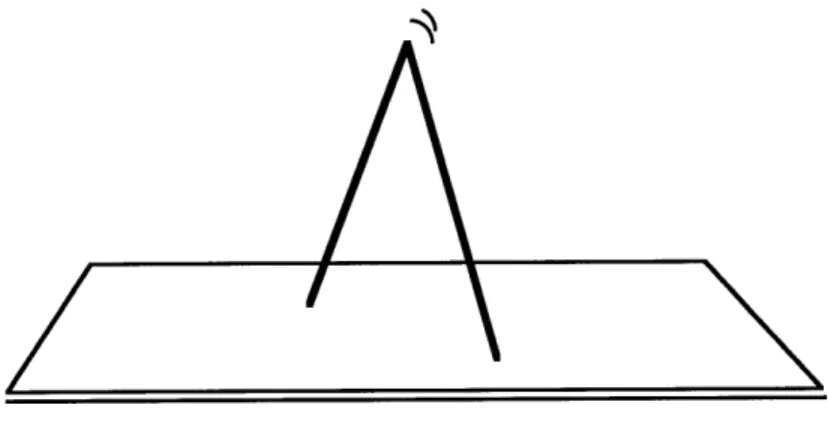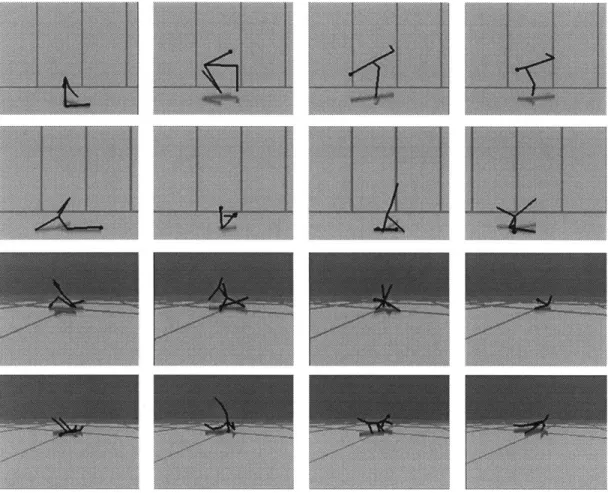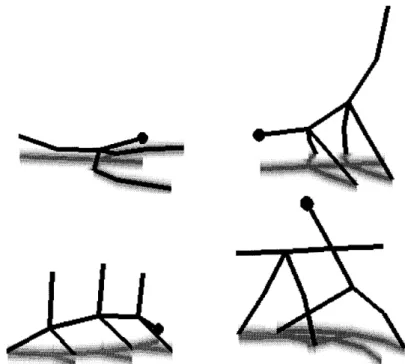Disney Meets Darwin
An Evolution-based Interface for Exploration and Design of
Expressive Animated Behavior
by
Jeffrey John Ventrella
MFA Computer Graphics/Video Syracuse University, 1987 BFA Art Education/Art History Virginia Commonwealth University, 1984
Submitted to the Program in Media Arts and Sciences, School of Architecture and Planning,
in Partial Fulfillment of the requirements of the degree of MASTER OF SCIENCE in MEDIA ARTS AND SCIENCES
Massachusetts Institute of Technology June, 1994
© Massachusetts Institute of Technology 1 f 94
All Rights ReseKd
\
l
\
Signature of AuthorPro ram in Media Arts and Sciences May 6, 1994
Certified by
Ronald MacNeil Principal Research Associat Program in Media Arts and Sciences
f)
/L Thesis{SupervisorAccepted by
Vv - Stephen Benton
Chairperson, Departmental Committee on Graduate Students Program in Media Arts and Sciences
Rotch
MASSACHUSETTS INST IUTE
Disney Meets Darwin
An Evolution-based Interface for Exploration and Design of
Expressive Animated Behavior
by
Jeffrey John Ventrella
Submitted to the Program in Media Arts and Sciences, School of Architecture and Planning, on May 6, 1994 in Partial Fulfillment of the requirements of the degree of
MASTER OF SCIENCE in MEDIA ARTS AND SCIENCES
ABSTRACT
In this thesis I describe a computer animation system called the Character Evolution Tool. It was developed both as a prototype system for animators and graphic designers, and as a testbed for the applicability of genetic algorithms in the design process. Although the focus is primarily on physically based articulated characters, these are considered as only a sub-class in the sub-class of all graphical objects which can exhibit expressive motion behavior, termed, "behavior objects." The Character Evolution Tool employs a genetic algorithm for the automatic evolution of goal-oriented behavior in animated graphics, with an overlay of interactive evolution. This overlay affords the user of the system the ability to encourage expressivity and communicative behaviors in the animated characters, as they evolve towards some otherwise pre-defined objective goal. Central to this system is an experimental technique for guiding the direction of evolution by way of a gesture drawn into the scene by the user. This gesture constitutes a novel approach to defining the genetic algorithm's objective fitness function, in that the characters are encouraged to emulate properties of the gestured motion, thereby assuming some of the expressive qualities that the user has specified.
Thesis Supervisor: Ronald MacNeil
Title: Principal Research Associate, Program in Media Arts and Sciences
Disney Meets Darwin
An Evolution-based Interface for Exploration and Design of
Expressive Animated Behavior
by
Jeffrey John Ventrella
The following people served as readers for this thesis:
Joe Marks, Ph.D. Research Scientist, Mitsubishi Electric Research Laboratories, Inc. Lecturer on Computer Science, Harvard University
Mitchel Resnick, Ph.D. Assistant Professor, Program in Media Arts and Sciences
ACKNOWLEDGMENTS
Thanks to Suguru Ishizaki for his continual inspiration and advice
I would also like to thank:
Ron MacNeil for the many interesting ideas and great conversations, which helped to form this thesis
Muriel Cooper for creating the Visible Language Workshop and the original vision, which has made this work possible
Louie Weitzman for his friendly advice and survival tips, and for the fuzzy kitties-Mies and Bou
All the other folks of the Visible Language Workshop who have contributed ideas and
debugging tips: Dave, Karen, Didier, BC, Craig, Allen, Maia, Xiaoyang, Lisa, Yinyin, Ishantha, Earl, Robin, Christa, John, and of course, Sukey
Mitch Resnick for his ideas about ideas about evolution
Joe Marks for his sound advice on the use of genetic algorithms in character animation
Tim Bird of Paws, Inc., for an inspired mixture of algorithms and laughs
Linda Peterson for helping me with organization, and much appreciated consultation
Brother Philip for the good laughs over the phone, which helped to reduce the pains in the frontal lobe
Nuala for a loving background to all the madness
TABLE OF CONTENTS
1. INTROD UCTION ... 7
Expressivity Through Guided Evolution... 8
Com puter Anim ation N ot Alive Enough ... 10
"M ove Like This"- Survival of the Fittest... 10
Evolution and Design... 11
2. BA CKGROUN D AN D RELATED W ORK ... 13
Autonom ous Character Anim ation... 13
Spacetim e Constraints ... 13
M otion Control... 14
The Genetic Algorithm ... 14
Artificial Life ... 16
Interactive Evolution... 17
Gesturing for Anim ation ... 19
3. APPROA CH ... 20
Two Levels of Evolution... 20
Gesturing...21
4. N UTS AN D BOLTS ... 23
Behavior Objects ... 23
The Articulated Figures ... 27
M orphology...28 M otor Control... 30 Periodicity...31 Physics ... 31 Architecture ... 32 The Interface ... 36 Gesturing ... 44
Saving and Loading Genetic D ata... 48
5. RESULTS...49
Subject's Responses... 49
Aperiodic Expressions ... 50
Prototyping and Phenotyping ... 50
Artificial Life ... 51
6. CONCLUSIONS... 52
An Anim ation Tool...52
A Research Environment for Exploring Evolution in Design...53
A Tool for Exploration of Evolutionary Principles ... 54
Design and Evolution... 54
User Interfaces to the Genetic Algorithm ... 55
Conclusion...55
7. FUTURE W ORK ... 56
Clip Behaviors... 56
Fam ily Trees... 56
Flesh and Bones ... 56
Interacting Characters ... 57
Glossary ... 59
Appendix A: The Morphology Scheme for the Articulated Figures... 61
Appendix B: The Motor Scheme for the 3D Articulated Figures...63
Appendix C: The Physics M odel for the Articulated Figures... 64
1. INTRODUCTION
In this thesis I describe a computer animation tool I have developed and the reasons behind its development. It is called the Character Evolution Tool. It serves both as a prototype tool for animators and designers, and as a testbed for the applicability of evolutionary algorithms in computer animation. The work is built on an assumption that not just animated characters but all kinds of graphical entities can have a "body language." It also assumes that this body language is something that can evolve over time to become
progressively more effective in expressing something, and having a style of moving about. These qualities are still not easily achieved in most computer-based character animation systems-yet they are abundant in classic cel animated cartoons.
To imbue characters with personality, humor, and style is a goal for many animators. This research can be described as an ongoing quest which began while I was exploring simple physically based human-like figures for animation. I wanted my figures to be able to move on their own, using internal forces, as a starting point for higher levels of control. This basic motivation has been the impetus for a number of other systems developed (Badler et al., 91). For enhancing humorous and stylistic qualities in my figures, I found that I required an added level to the techniques developed thus far: a highly interactive interface allowing enhanced communication between the animator and the animated.
Genetic algorithms (Holland, 75) have been used recently for evolving goal-directed behavior in physically based, articulated figures (Ngo and Marks, 93). (Refer ahead to "Background Research" for a quick definition of genetic algorithms). This work has successfully shown that genetic algorithms are effective in optimizing their motions for locomotion and other objectively defined goals. But it has not, however, focused on a means to imbue the figures with expressive characteristics and stylistic variations by way of a designer's interactive contribution to the evolutionary process. I have proposed to address the problem of designing humor and body language in animated characters with an hypothesis: expressivity, not just objectively-defined behaviors, can be the product of progressive refinement. I have attempted to test this by combining the automatic
blending of automated and user-guided evolution. This system can be seen then as
extending the standard genetic algorithm in that it adds multiple levels of interactivity to the automatic process, to achieve higher levels of control. This interactivity is manifest on two basic levels:
1) interactively guiding evolution
2) gesturing to demonstrate motion
Expressivity Through Guided Evolution
In this system, the means for deriving expressive behavior in these characters is biologically inspired. It uses an evolutionary algorithm which allows identifiable
behavioral qualities in animated graphics to emerge over time. The term, "expressive" as used here is defined as the ability of a graphical object, through MOTION, to evoke information, ideas, or feelings, for the sake of communication, humor, or aesthetics.
As a first glimpse of the varieties of "characters" one can evolve with this system, Figure 1 illustrates three varieties (swarms, blinkers, and articulated figures).
Figure 1 Three stages of evolution for three of the classes of characters available in
this system: swarms, blinkers, and articulated figures.
This illustration shows three stages of each character's evolution towards more expressive, and otherwise useful, forms and motions. The swarms become more life-like, the blinkers become more effective attention-grabbers and acquire optimal blinking rates (in this
illustration, only shape and size can be shown), and the articulated figures exhibit locomotion or humorous dance-like movements.
The graphical objects I have focused on in this research are animal-like articulated stick figures with autonomous motion, but the concepts and techniques from this class of graphical objects have been carried over to a larger class of graphical objects which can exhibit behavior (they can change states over time). This includes graphical interface widgets, and other object-oriented graphical agents which can have behavior. They are called, in this thesis, "behavior objects." In Figure 2, the generic concept of a "character" is illustrated, as being any behavior object which can exhibit dynamic behavior for purposes of expressivity.
static graphics with no behavior behavior objects
animated "characters"
(with dynamic behavior and expressivity) interface design character animation 7
-Y
e
Go oL (r
Figure 2 The general concept of a "character" as defined in
Tool-a graphical object with expressive dynamic behavior.
the Character Evolution
Thus the class of objects known as animated characters can be expanded to include all graphical objects which can exhibit motion behavior. In this thesis, I sometimes reference this general notion of character, in order to place my work in the larger context of
communication graphics. Primarily I will focus on the articulated figures, and a set of tools for directing this class of behavior objects, as the focus of this research.
Computer Animation Not Alive Enough
Physically based animated characters whose behaviors adapt through the use of a genetic algorithm have been shown to demonstrate realistic behaviors such as locomotion. But they are often devoid of the expressive content which makes traditional hand-drawn characters so effective in comparison. In these systems, the science of the design of animated characters is not yet useful for the art.
Animation, seen as an art, should be concerned more with motion-based expression and communication of certain ideas and feelings than on mere simulation of physics or animal behavior, which has been a major focus of most research in this area. In general,
animators have a story to tell, and it is usually not totally reliant on physical realism or efficiency of motion within spacetime constraints. The Disney tradition of character animation reminds us that physics and biological realism are routinely violated for the purposes of character personality and narration. Systems which incorporate genetic algorithm's for evolution of behavior in articulated figures solve the physical problems of optimizing behavior, but do not afford the optimization of expressivity, above and beyond the constraints from evolutionary fitness pressures. Optimization of expressivity cannot easily be accomplished with straightforward fitness functions. This thesis assumes that it requires some feedback with a human in the optimizing loop. Animation systems would benefit from tools which support expressive communication between the animator and the animated, as things evolve, while simultaneously keeping behaviors within objectively defined constraints.
"Move Like This"-Survival of the Fittest
An experimental method for interactively demonstrating motion by gesturing into the scene has been implemented in the Character Evolution Tool. It will be discussed as a potential new contribution to character animation research. Since this system is based on an evolutionary paradigm, the gesture tool essentially allows a free form line which is drawn into the scene to become a form of evolutionary pressure which drives a character's motions to assume attributes of the gesture. Two gesture matching algorithms have been implemented which compare the input gesture with the character's motions. Figure 3 offers a cartoon explanation of the concept behind the gesture tool.
Figure 3 A gesture is drawn by hand, then the individual characters of a population
are evaluated according to how closely a body part (the head) follows the gesture, through time. This evaluation is used as a fitness criterion for evolution of behaviors in the population. Over generations, the motions begin to mimic the motion of the gesture.
Evolution and Design
Underlying this research is the idea that Darwinian Evolution and Design, often considered antithetical processes, can be brought together into one coherent system. We often refer to Design as a top-down organizational process, involving decision and planning, and we consider Evolution to be a bottom-up, distributed process, involving chance. But creative design (as viewed in this thesis) generally involves a certain amount of bottom-up
organization and chance. The idea in this thesis is that computational evolution can augment the design process for this reason. Genetic algorithms are good at searching for optimal solutions in arbitrarily large multiparameter spaces. Design can also be said to be an activity of searching a large problem space for solutions. Both make use of
experimentation, both make use of iterative evaluation. These kinds of notions are much more thoroughly explored by Hybs and Gero (92).
In creative design, especially in the earlier stages of the design process, designers are not always completely aware of what they are making or how to go about doing it. Serendipity often plays a role in the process, and one generally improves the working design iteratively. In short, the act of designing itself is an evolutionary process. Considering genetic
can see how a process based on evolution can be merged with a design tool-if the interface is carefully constructed to support this. I have attempted to develop an interface which brings these processes together, within the context of animated graphics.
2. BACKGROUND AND RELATED WORK
Autonomous Character Animation
The fine art of character animation has evolved from what it was in the classic days of Disney, Warner Brothers, and Fleischer. The introduction of computer software in the animation studio has influenced the industry and the way we think about creating and even watching an animated character. Animation was originally a craft whose structure was based primarily on the animation cel-the 1/30th-of-a-second picture frame-as the main building block. This is a direct outcome of the physical properties of movie film.
The introduction of computational techniques which simulate the physics of interacting bodies and the motor control systems of animals has introduced new systems for
generating motion, and has brought into the art of animation the concept of autonomy. In these task level animation systems, the animator only needs to specify general goals and the character (as an autonomous agent) takes care of the many details necessary to accomplish this task (Zeltzer, 91). This is still more the realm of research than actual applied use, but some predict that the art of animation may, in the future, appear more like the direction of actors in a movie than the drawing of hundreds of picture frames.
Spacetime Constraints
In the field of character animation research, there have been a number of developments in methods for generating goal-directed behavior in characters represented as articulated
skeletal figures (Sims, 87), (Cohen, 92), (Ngo and Marks, 93), (van de Panne and Fiume,
93). These figures are modeled in virtual physical worlds for realism, and their internal
motions can adapt, within the constraints of that physical world, to obey user-specified constraints, for the purposes of locomotion and other specified behaviors. This approach to generating motion is often referred to as the spacetime constraints paradigm (Witkin and
Kass, 88). The spacetime constraints paradigm is a technique which aims to automate some of the tasks of the animator, whereby dynamics associated with the physics of motion are left up to a physically based model, and the autonomous motions of articulated bodies are automatically optimized within the system. In these systems, the animator tells the character where to go and when to get there, for instance, and the spacetime constraint system automatically computes the optimal motions of the character for getting there at the right time. Traditional animation concepts such as squash and stretch, anticipation, and follow-through, have been shown to emerge through the spacetime constraints system.
Motion Control
The spacetime constraints approach assumes that the articulated figure has some ability to change its internal structure (like the angles in its joints) in such a way as to affect goal-directed behavior. Thus, not only must some physics model be used, but there must also be some modeling of a motor control system in the character. There have been many kinds of motor control used in this regard. Many, as one might expect, are biologically inspired, and use theories from neurology and physiology. The virtual roach developed by McKenna (90), for instance, uses a gait controller which employs a series of oscillators which generate stepping patterns, analogous to a system observed in actual roaches. The articulated figures developed by Ngo and Marks (93), van de Panne and Fiume (93), and others, use stimulus/response models which allow the characters to sense their relation to the environment, and to move their parts accordingly, each individual action being the direct result of stimulus. Typical senses used in these models include proprioceptive
senses of joint angles, and contact with the ground surface, for a number of body parts. Responses typically involve changing various joint angles. Once a stimulus/response model is created, exactly what kinds of responses should be activated by what sensors for goal-directed behavior is a difficult problem, and can be a difficult design task. This is where the evolutionary algorithms have proven useful.
The Genetic Algorithm
It may not be too surprising that the genetic algorithm should have entered into the domain of autonomous character animation research-it is biologically inspired, and it is good at dealing with large search spaces (such as finding the best parameters for locomotion). Below I will explain the primary concepts of the genetic algorithm.
The genetic algorithm (GA) (Holland, 75) (Goldberg, 89) is a searching and optimization technique derived from the mechanics of Darwinian evolution. It operates on a population of individuals (potential solutions to a problem), updating the population in parallel, over many generations. In the case of this research, a good individual, or solution, is a setting of motion attributes which cause a character to perform some desired behavior. As the
population is updated in the GA, the better (or more "fit") individuals pass on more of their characteristics to the individuals in the next generation, while the less fit individuals pass on less. Since individuals reproduce through sexual reproduction, offspring have the potential to inherit good traits from two fit parents, taking the best of both worlds and thereby acquiring even better traits. The result is that the population as a whole progressively improves over a series of generations.
Individuals within a population are represented in the GA as strings (in the classic GA they are bit strings of l's and O's but strings have also been used which consist of other element such as real numbers or integers). A string is sometimes referred to as a chromosome, and the elements in the string are sometimes referred to as genes. The chromosome, taken as
an encoded representation of an individual solution, is called the individual's genotype. Each gene in the genotype influences some attribute or attributes in the individual (with the whole set of attributes comprising the phenotype). Thus, the phenotype is the expression of the genotype. The fitness of an individual is determined by an objective fitness
function-an evaluation criterion which measures some feature, not of the genotype, but of the phenotype. Figure 4 illustrates this concept-that the phenotype is the representation which is evaluated, and that the genotype is the representation which is affected by the
evaluation.
Genetic
Algorithm genotypes
Figure 4 Schematic illustrating a basic concept in genetic algorithms-that there
are two components to a representation: the phenotype and the genotype. The genotype is an encoded set of parameters that determine attributes in the phenotype. The phenotype is evaluated by an objective fitness function or a human evaluator, and the genotype is affected by this evaluation, through the operators of the genetic algorithm.
Many varieties of the GA have been implemented, but they all have some basic things in common. A typical GA works like this:
Initialize An initial population of genotypes is created with random settings of gene values.
Evaluate Each genotype's resulting phenotype is evaluated for fitness.
Select Pairs of genotypes are chosen randomly from the population for mating-with the chances of being chosen proportional to fitness.
Crossover These genotypes mate via crossover: they produce one or two offspring genotypes, which inherit randomly sized, alternating "chunks" of gene
sequences from each parent.
Mutate Each offspring's genes have a chance of being mutated (isolated genes can be changed randomly-this encourages experimentation in the population,
across generations).
Update The offspring genotypes comprise the next generation, and replace the genotypes in the previous one.
Repeat The process is repeated, beginning with the Evaluate step, for a set number of generations, or until the average fitness of the population reaches a desired level.
Most GA's incorporate variations on this form, and experimenters use different settings for things like population size, mutation rate, fitness scaling, and crossover rate (affecting the sizes of the parental chunks which the offspring genotypes inherit).
Artificial Life
Artificial Life is the study of human-made systems which exhibit behaviors that are characteristic of natural organic processes. It complements the traditional biological sciences, which are largely concerned with analysis, by attempting to synthesize life-like systems (Langton, 91). Life, and the myriad systems which are characteristic of life, are seen as emergent behavior. Many artificial life researchers use genetic algorithms in modeling the evolution of self-organizing phenomena, employing a bottom-up methodology. Reproduction, predator/prey dynamics, primitive communication, locomotion, and functional morphology are among the phenomena that have been
modeled. The influence of artificial life concepts can be witnessed in a growing number of software products for exploring evolution and emergent phenomena. These include SimLife and other "Sim" products by Maxis, and many others.
Interactive Evolution
Genetic algorithm-based systems which replace the objective function with a human are typically called Interactive Evolution systems. These have been developed by (Dawkins,
86), (Sims, 91), Latham (Todd, 92), (Tolson, 93), (Baker, 93), and others. What
distinguishes these systems from other uses of the GA is that they incorporate a human fitness function. In these systems, abstract forms (typically) are evolved through the selections of favorable images by a user, through a number of generations of evaluations. These systems support the notion of an "aesthetic search" in which the fitness criteria are based primarily on the visual response of the user. Interactive evolution is useful when fitness is not measurable by way of any known computational evaluation techniques. As an example of an interactive evolution system, Richard Dawkins' Blind Watchmaker is illustrated in Figure 5. The software was developed as an accompaniment to the book by the same title, as an interactive illustration of evolutionary principles. In the illustration, the top panel shows one generation of a population of biomorphs from which a user has chosen an individual to spawn a new generation, with genetic mutations for variation. By repeating this action a number of times, one can breed a desired biomorph. This system employs asexual reproduction (one parent per generation). Many other interactive evolution systems, including the Character Evolution Tool, allow for sexual reproduction as well, in which two or more individuals can be chosen from the first generation for mating, to create the next generation.
r Z File Edit Album
r File Edit Album Operation Uiew tations Pedigree (M -10 -5 0 10 10 7 2 i+1 AsymUpDnj+l0j+5 +
Figure 5 Two views of Dawkins' Blind Watchmaker (with a schematic overlay) as an
example of an interactive evolution system. The top panel shows a population of biomorphs from which a user has picked an individual to spawn a new population with genetic mutation, shown in the bottom panel.
Gesturing for Animation
Scripting by Enactment techniques have been developed for mapping motions from a
human body to an animated 3D computer model (Ginsberg, 83). In these techniques, multiple cameras placed in a room sense diodes attached to a performer's body as he/she moves about-the system merges the camera views to synthesize the 3D model. One can use this technique for quick scripting of expressive movements in an animated character, and it requires no drawing.
Still, most animators (at least in the present) are also graphic artists, and are very skilled in the art of expression through drawings. Tools which complement this skill have been explored. Algorithms which extract features from human-made gestures drawn in a computer display have been developed for enhancing the communication between user and computer in Computer-Aided Design research. Donoghue [93] has developed a system in which attributes from gestures such as rate of drawing, direction, "tilt" of the stylus, pressure on the tablet, and other features are parsed and then used for a variety of applications. These applications include rough prototyping for page layout design, and quick scripting of animated character movements. This facet of her system is derived from earlier work by Baecker (69) which demonstrates the use of an input stylus to create a motion path specifying frame-by-frame positions of animated characters. For specifying character animation movements in Donoghue's system, a sketching grammar interprets geometric aspects of the sketch input and temporal aspects of how the character should move. The Character Evolution Tool may be seen as extending Donoghue's work in using gestures to specify motions in characters. The added dimension is that this system allows the characters the ability (as autonomously moving articulated figures) to optimize internal motions to best approach the motion specified by features of the gesture. It includes
3. APPROACH
In the Disney tradition, animation is the illusion of life (Thomas, 81). Character animation research has added to this the simulation of life. Animals are complex things which, according to Darwinism, have become the complex things that they are because of
evolution. Artificial life researchers take this approach when modeling artificial organisms, in studying emergent self-organizing phenomena. As indicated by the background
research I have outlined, the evolutionary techniques which are central to artificial life research have also begun to influence character animation research. I have taken this approach, with an added emphasis on the creation of funny characters with personality, by way of interactive techniques. One might infer from the title of this thesis that the
Character Evolution Tool is based on "survival of the cutest." But it is aimed at being more than just this-the qualities that one can extract from a population can have a great range of body language.
Two Levels of Evolution
In this thesis, I consider expressivity to be the product of progressive refinement, which requires that a human be in the GA loop. Figure 6. illustrates a behavior in which the user has affected the course of automatic evolution via an overlay of interactive evolution.
Figure 6 The top panel illustrates a walking pattern which emerged in a population
under fitness pressures for locomotion and holding the head high. This character's behaviors have been automatically optimized through these fitness pressures. The bottom panel shows a character from the same population in which a user affected the direction of evolution by favoring ancestors who walked with a desirable style.
In the top panel of the illustration, a walking pattern is shown which emerged in a
population evolved under fitness pressures for locomotion and holding the head high. This character is optimized according to these fitness functions. The bottom panel shows a character from the same population in which the user has affected the direction of evolution
by favoring ancestors who walked with a particular style. This is accomplished by
combining the automatic optimizing capabilities of a GA with interactive tools, and allowing a blending of automated and user-guided evolution. And perhaps most importantly, the proportion of user-guided vs. automated evolution can vary.
This can be seen as the overall approach: a system which blends automatically-driven evolution with the critical vision of an interacting human. Essentially, the source of evolution at any given time may not be entirely distinguishable to the user-for instance, if an active objective fitness function is encouraging locomotion, through the GA, the user may also be encouraging behaviors that make the locomotion look like swaggering, or skipping, or shuffling. "Shuffling", then, can be the label the user attaches to this behavior. In the final analysis, the user may not care how much a final behavior was influenced by objective functions vs. his/her control. What counts is that a desirable behavior was achieved.
L~7
Gesturing
Lying at the conceptual center of this thesis is the gesture tool, which was conceived for the purpose of enhancing the interactive level of genetic algorithms for character animation. The idea was to design a tool which allows an interactive motion from the user to be brought under the grasp of the genetic algorithm, which uses that motion in a specialized fitness function. Although it is an experimental component of this thesis, tests have shown success.
Here the notions of design and evolution are brought together in an experimental marriage. The design part can be described as the line-drawing that is gestured into the scene by the user. The evolution part comes into play as that gesture becomes a component in a
specialized fitness function, which affects the evolution of the population. In developing this technique, two kinds of algorithms were implemented which interpret features of the
gesture and relate them to some features of the characters as they move. The first
algorithm compares the absolute position of a 2D character's moving head to the absolute position of a traveling point on the gesture. I found that this algorithm imposed too harsh a constraint on the evaluation. The second algorithm compares the direction and speed of the character's head motion to the direction and speed of a moving point on the gesture. This algorithm was found to be more flexible in that it allowed comparisons at a distance. These two algorithms are described in more detail at the end of the following section.
4. NUTS AND BOLTS
Behavior Objects
Twelve species of behavior objects have been implemented. I have experimented with many kinds so as to explore the uses of evolution in a number of graphical domains and to generalize my system for purposes of demonstration and research. Most of the behavior objects are graphical, and most are dynamic in the sense that they exhibit animated motion. Below they are each listed and briefly described, accompanied by four sample snapshots to
show variety.
Color images representing Josef Albers' "Homage to the Square" series, with variable
color components in the regions in the image
Fractal tree biomorphs similar to Dawkins' Blind Watchmaker biomorphs (Dawkins,
86), but incorporating more degrees of asymmetry
. . . . . . . . . . .... . . . .... . .
Random grammatically correct sentences in which grammatical variations and vocabulary can be changed (these are the only non-graphical behavior objects)
Biomorphs consisting of curves defined by multiple sine functions.
Blinkers - flashing, shifting rectangles (these are meant to be candidates for effective
attention-grabbers in a graphical interface)
.~~ . ~ . . .. . . . .
MIN~ ...
Bouncing balls with simple physics constraints determining their motions, and some
autonomy (they can jump in a variety of ways)
Animal Microworlds consisting of Logo-like turtles, bits of food, and
predators-behaviors in the population of turtles can evolve for better eating and to avoid being eaten.
Swarming/schooling/flocking bits which exhibit collective behavior-variations in
2D articulated stick figures with a fixed topology and variations in rhythms of multiple
joint angle motions
2D articulated stick figures with variable morphology as well as motions
3D articulated stick figures with variable morphology and motions
3D articulated stick figures like above except the variations in morphology are
constrained to a more realistic segmented animal-like scheme
As indicated by this list, a variety of domains have been explored within this system. What do they all have in common?
- They have behavior (their states can change over time). There are two distinct ways in which their states can change:
1) most of them are animated: they are continually changing their states in the
sense that they exhibit autonomous motion. For instance, the bouncing balls are always bouncing.
2) The nature of this motion can also change (the attributes which define the kinds of motion). These kinds of changes are the results of genetic operations.
For instance, the degree of upward jump in a bouncing ball can change the nature of its motion. Non-motion attributes can change as well, such as the colors in the "Homage to the Square" species.
- Each behavior object has an associated genotype (the behavior object itself is the phenotype).
- They occur in multiples (as a species consisting of a population of individual behavior objects). Another way of thinking about them is that they are variations on a theme.
- Individual genes of the genotype can be manipulated in real time resulting in visual transformations of individual attributes, as indicated in figure 7.
tweaking knee angle gene
Figure 7 The user can "open up the hood" to see the contents of a chromosome. As
the user tweaks an individual gene, the affects of changing this gene can be seen in real time in the phenotype.
-D
mp
~ThFHL~
The Articulated Figures
The species of behavior objects which I have concentrated on in this thesis are the
articulated stick figures. An earlier species which is not represented in this system is seen as a predecessor to the current phylum. It is called "Walker", and the anatomy consists simply of two 3D sticks (legs) joined together to form a hairpin shape (Figure 8). A Walker can autonomously change the angles at which the legs are joined together in a variety of ways. The changes of the angles in each of two angular coordinates in both of the legs are determined by sine functions whose amplitudes, phases, and frequencies can vary from one individual Walker to another (these parameters remain constant during the lifetime of the individual). The parameters are represented as genes and a GA is used to optimize these genes for walking behaviors (Ventrella, 92).
Figure 8 Walker
For this thesis, four new species of articulated figures have been designed. Each species that I have developed is more complex then the previous one. In a very real sense to me,
they evolved from one to the other as I progressively extended my design of the basic
phenotype. The latest species, which I call the "Vertebrates", constitutes the most complex phenotype design in the Character Evolution Tool. Figure 9 shows four variations each of the four example individuals of each species of articulated figures.
Figure 9 Four random variations from each of the four species of articulated figures
are shown. The top row shows the 2D species with fixed topologies, the second row shows the 2D species with variable morphology, the third row shows the 3D species with variable morphology, and the last row shows the 3D species (called the "Vertebrates") with variable morphology, incorporating a segmented scheme.
Morphology
The figures are represented as rigid bodies made of interconnected limbs of varying lengths, joined at various angles. Each figure conforms to a tree-like topology-no closed loops can occur among the parts. The orientations of the limbs are hierarchical, as in most skeletal systems (for instance, when your elbow bends, everything from the elbow down rotates about the elbow joint). A body is deformable internally (autonomous changing of joint angles) but is rigid in the sense that it does not deform passively in response to environmental stimuli, such as collisions.
The human form emerged from the animal kingdom through natural selection according to Darwinism. Likewise, in this little world, human-like forms can emerge. In the spirit of
morphologies. The number of limbs, the angles at which limbs are connected, and the lengths of the limbs can vary according to genetic variation. This opens up the arena for many possible forms as well as motions. Appendix A offers a detailed explanation of the scheme for morphology developed for the Vertebrates. Figure 10 shows four examples from the Vertebrates, and demonstrates the variety of morphology in an initial un-evolved population.
.....
Figure 10 Four examples of the Vertebrates, the most complex of the articulated
figure species, demonstrating morphological variation.
I have experimented with evolving the Vertebrates without any interactive intervention,
with fitness pressures for locomotion to see what would spontaneously emerge. The most interesting finding is the fact that morphology and motion behavior usually evolve in tandem. A form can constrain a motion style, but also a highly fit motion style can encourage emergence of forms which support that motion style. These notions were the impetus for an artificial life experiment I had developed parallel to this thesis for exploring emergent morphology along with locomotion (Ventrella, 94). It was demonstrated that anatomies and locomotion behaviors reminiscent of some familiar species of animals tended to emerge together. The environment for this artificial life experiment has been
folded into the Character Evolution Tool so that one can explore emergent morphologies and motions for their own sake.
Motor Control
The motor control of the collection of figures in the Character Evolution Tool uses the same scheme as the Walker. Motion is the result of multiple simultaneous sine functions. In a similar fashion to McKenna's (90) motor control for the virtual roach (yet much simpler), this system utilizes a rhythmic motor control program which consists of a combination of sinusoidal angular motions in multiple limbs. The differences from one figure's motor program to another's can vary greatly according to genetic variation. A figure's motor program is continually active at all times and cannot change during the figure's lifetime. This is a time-based motion control system, as opposed to a physical-based control system. Physical-physical-based control systems are used in [Ngo and Marks, 93], [van de Panne and Fiume, 93], and others, in which the physical aspects of the
environment determine the motions of the limbs, such as contact with the ground surface, global tilting angle of the figure, etc. My figures have no stimulus/response modeling, nor any proprioceptive senses, and so their motor programs cannot change in response to the environment.
In the simplest of the articulated figure species, consisting of five limbs (figure 11), joint angle changes are determined by collections of sine functions (one sine function for each of four joints).
Figure 11 The simplest of the articulated figures. To achieve motion, the four joint
angles (shown as arcs) are changed according to sine functions of varying amplitudes, frequencies, and phases.
In the more complex species which have variable morphologies, I have devised a different scheme, due to the fact that the number of limbs (and therefore joints) can vary. Also, the joint angles (being 3D) must be specified with more than one angular coordinate (such as
yaw, pitch, and roll-I deal with yaw and pitch only). The scheme collapses the number of
such that the species can have a fixed genome length. This scheme is described in more detail in Appendix B.
Periodicity
In any one figure, the frequencies of sine functions controlling angles in the joints are set to be either equal or having ratios of 2.0 or 0.5. For instance, one joint angle sine function may have a frequency of F, and another might have a frequency of F/2 or F*2. Having whole-number frequency ratios encourages periodic motions in the figures-every gesture the figure makes is certain to be repeated over and over again as the animation runs. This is helpful for the acquisition of locomotion skills, in which periodicity can help (and it makes them potentially good dancers as well). But, as we shall see in the discussion on the gesture tool below, this can impose constraints on the matching of figure motions with the user's gesture.
Physics
In the models that researchers have developed for simulation of articulated stick figures using such techniques as forward dynamics (Badler et al., 91), many realistic phenomena can be produced such as falling under gravity, bouncing collisions, and momentum and inertia effects. Many of these models are very robust, and sacrifice computational speed for simulation accuracy. The amount of detail in an implementation of a physics model should reflect the purpose of the research, or of the art, in some cases. I have constructed a
qualitative physics model which works sufficiently for the general purposes of this
research (dynamic design for visual communication and entertainment). It is simple yet it produces many of the salient features of interacting rigid bodies in the real world, such as gravitational effects, inertia, angular and translational momentum, friction, and dampening. Appendix B offers a more detailed description of the physics model developed for these figures.
This abbreviated physics model also does not place a burden on computation and thus is very fast for the purposes of real-time animation. As many as twelve of the Vertebrates can be animated at the same time on the screen at animation rates of more than ten frames per second. The ability to animate in real time or near real time is crucial for the interactive evolution aspect of this system to work-the user must experience true motion in each of the figures in order to do any comparative evaluation of subtle motion styles.
Architecture
There are five major components of this system:
1) the genotype library
2) the phenotype library
3) the genetic algorithm
4) the automatic evolution engine
5) the interface-which ties all of the other parts together.
Figure 12 illustrates the overall scheme of the Character Evolution Tool, showing each of these components.
interface
fitness
values
genotype library
.1
phenotype
---
>library
Figure 12 The overall scheme of the Character Evolution Tool. Through the
graphical interface (lower left of the illustration), the user has the ability to control many levels of the system.
1) The Genotype Library
A large library of genotypes are held in memory during interaction with this system. This
library contains the genotypes for each species, with each species consisting of a maximum
automatic evolution
engine
population of 100 behavior objects (some smaller subset of the total population is typically active during interaction). Each species' genome can have anywhere from 1 to 50 genes. Genes are stored as floating point numbers ranging from 0.0 to 1.0. These values are interpreted in a variety of ways by the phenotypes as parameters for visual attributes. For instance, a gene specifying the color of an object might be scaled to an integer value
ranging from 0 to 255; a gene specifying an amplitude of joint motion might be scaled to a real number value ranging from 0.0 to 90.0, etc. The genotypes in the whole library are initialized as random at the start of the program run. As the user manipulates genes, interactively evolves populations, or initiates automatic evolution, the genotypes are changed accordingly. A population of genotypes for one species can be saved in a file at any time, and previously saved files can be loaded into the library at any time.
2) The Phenotype Library
Associated with each genotype is, of course, a phenotype. Twelve species of phenotypes (behavior objects) have been created and each are loaded into memory at the start of the program run (these were outlined at the beginning of section 4). At any one time, one of these species is displayed on the screen as a population (showing variation). While a species is active, the user can manipulate the genotypes associated with the behavior objects in that species either by tweaking genes directly, interactively evolving, or initiating
automatic evolution. In each case, as genotypes are altered, the phenotypes reflect the changes immediately as visual transformations. At any time, the user can switch to another species and work with it for a while and then return to the previous species-the state of the genotypes will remain unchanged, upon switching species.
3) The Genetic Algorithm
The GA is in charge of the basic genetic operators: selection, mutation, and crossover. It is activated when the user selects the "new generation" button after assigning fitness values to favored individuals, or when the automatic evolution engine has completed an evaluation pass-or some mixture of both. To do its thing, the GA requires fitness values supplied
by interactive evolution or the automatic evolution engine. This is the only input the GA
uses in determining the probabilities for selection of each individual for reproduction.
Selected individuals reproduce via crossover: two selected individuals contribute alternating chunks of their chromosomes to each offspring in the new generation. These chunks can have varying lengths. This is determined by the variable crossover rate: As parental genes
the other a number of times. The probability of switching is determined by crossover rate. Crossover rate is computed per species, and is inversely proportional to the species' genotype size.
The setting of mutation rate (interactively controllable) determines the chances of a single gene in a genotype being randomly mutated immediately after reproduction. In mutation, a gene's value can increase or decrease by as much as 1.0 or -1.0, but with higher chances in the 0.0 range. The mutation operator insures against a resulting mutated gene value exceeding the bounds of (0.0, 1.0) by a wrap-around procedure. The mutation rate can affect the amount of variation in the offspring. It can be seen-in the context of creative design-as a determinant for the amount of automatic experimentation in a population, as it evolves.
4) The Automatic Evolution Engine
Some species of behavior objects come with the ability to evolve according to one or more pre-defined fitness functions. This component essentially allows the fitness functions to kick in and to affect evaluation of the phenotypes automatically. Examples of fitness functions are offered in the section which details the Interface. When the automatic evolution engine is turned on, a biological clock is initialized which has a set duration-at the end of this duration, all the phenotypes are evaluated, ranked by fitness, and mated proportional to ranking. The new generation of phenotypes is automatically created and appears on the screen at the end of the biological clock's period, and the cycle begins again. At any time the user can contribute to the evaluation of the phenotypes via interactive evolution. The user can also set the proportions of multiple fitness functions to guide the direction of evolution.
5) The interface
The interface brings together all the parts of the system and displays a species of behavior objects in multiple windows. Through the interface, the user can interact with the other parts of the system, using a mouse as input device. These interactions include:
- choosing among different species of behavior objects - changing the size of the population
- initiating automatic evolution
- adjusting the weights of the pre-defined fitness functions
- adjusting mutation rate - tweaking genes directly
- resetting the entire population's genotypes to random values - interactive evolution
- saving and loading genotype files.
The Interface
A large amount of this research has been dedicated to visualizing the processes of the GA
and making the many components of the GA accessible to the user. To begin, a schematic of the interface is given in Figure 13, indicating each of the functions.
change population
size
get explanation explanation of the system
behavior object
of current
species chromosome icon
initiate change to automatic another evolution species engine update generation (sexual reproducti
I
\/Iadjust save and
mutation load rate genotypes spawn generation on (asexual) quit randomize species genotypes
Figure 13 A schematic of the interface. In this depiction, twelve individuals from
the simplest articulated figure species are displayed, showing variations among them. Each of the interactive functions are labeled.
Channel Surfing
One can use the interface in a passive mode-just watching a behavior objects do its thing, switching to another species of behavior objects, turning on automatic evolution and watching the results, and reading the explanations which accompany each species. The passive mode is suggested as a way to get to know the system.
Evolving/Gene tweaking
One can also actively change the behavior objects by affecting their genotypes. This can be done on three basic levels:
1) The Watson and Crick Level (Resnick, 94), where the user can open up a genotype
and tweak individual genes and directly see their results in the phenotypes
2) The Darwin Level, where the user controls evolutionary processes pertaining to mutation rate, reproduction styles, and fitness criteria
3) The Creator Level, where the user is thinking primarily on the phenotype level, and
designing through interactive evolution, gesturing, etc.
These three levels are described below:
1) The Watson and Crick Level
This is the lowest level of control. The user can click on a button at the right of each
chromosome icon to "open the hood" and see the gene values represented as rows of slider knobs, which can be interactively adjusted. Changing the value of an individual gene results in real time visual results in the behavior object. For instance, if a gene specifies the length of a limb in an animated character, changing the gene value would result in the limb visually increasing or decreasing in length. Figure 14 shows an example of a behavior object (the fractal tree biomorph) whose genotype has been opened for tweaking.
Figure 14 A behavior object's associated genotype can be opened and individual
genes can be tweaked. The genes for the species shown (the fractal tree biomorph) are labeled at the left of the genotype panel. They are: X (position) Y (position), (branching) angle 1, (branching) angle 2, size, (fractal) levels, branch length ratio, and thickness (of lines).
At this level one can get to know the particular effects of each gene on the phenotype by interactively adjusting the values and seeing the results in real time. A technique similar to this is described by Oppenheimer (91), who suggests that this kind of isolation of input parameters to a phenotype and the instantaneous feedback from adjusting the parameters affords one the ability to sense the geometry, enhancing intuition about the visual form.
Behavior objects whose genomes are relatively short, such as the tree biomorph (having eight genes) are easy to explore in this mode. Other behavior objects, such as the Vertebrates, have on the order of fifty genes, many of which have indirect effects on the phenotype and cannot be noticed until other genes are changed as well. The Watson and Crick Level becomes problematic in this case-which actually serves a didactic purpose,
demonstrating how one cannot easily design form and behavior in high-dimensional search spaces by manipulating isolated parameters. One must move up to a higher level of
abstraction, such as the Darwin level.
2) The Darwin Level
On this level, one can utilize the dynamics of Darwinian evolution by turning on the
automatic evolution engine and setting up fitness functions. One can also set mutation rate, population size, and the duration of the biological clock's period.
Some of the species come with their own sets of fitness functions. These species can be automatically evolved according to fitness functions and the relative weights associated with multiple fitness functions, if there are more than one. At the end of each evaluation period, the values created by the fitness functions for each individual are added up to
determine the final fitness values. A fitness function can contribute a positive (reward) or a negative (penalty) amount to the final fitness.
One example of a species which has a pre-defined fitness function is the fractal tree biomorph species. Its associated fitness function rewards each biomorph according to the degree in which the vertices of the biomorph are distributed in the picture space. This is done by taking the sum of the distances between every point with every other point in the biomorph (if each is within the picture space). This encourages the evolution of shapes in which the branches tend to be space-filling. Figure 15 illustrates four un-evolved
biomorphs sampled from a population of twenty-four (shown at top) and one biomorph (shown at bottom) representing the population after this fitness function has affected evolution for twenty generations.
... . .N . . %...N'M:
Figure 15 Automatic evolution of space-filling behavior in the fractal tree biomorph
The articulated figure species each come with a set of five fitness functions, the
proportional weights of which can be adjusted by the user. Figure 16 shows a close-up of the automatic evolution engine with different settings for weights in each of these fitness functions. Each of these can be adjusted by the user at any time, as well as the biological clock (shown as "evaluate duration." (the other buttons in this panel will be explained below as I discuss their associated functions).
Figure 16 The automatic evolution engine control panel showing fitness functions for
These fitness functions are:
Travel Reward
The distance between the starting point and the ending point after the evaluation period is used as a positive contribution to overall fitness-this promotes locomotion.
Head up Reward
To encourage more realistic mammal-like (and human-like) morphology and motion
Gesture Reward
When a gesture is drawn into any window, features of this gesture (seen as a
space-time object) are compared to features in each of the characters' head motions
(another space-time object) better matching of features determines a positive contribution to fitness.
Flip Penalty
The angular velocity of each figure's body is accumulated in a variable during evaluation which is used as a penalty for excessive rotational motion.
Head Bump Penalty
Each time a character's head encounters the ground surface during evaluation, an amount is subtracted from overall fitness
Setting the weights of these functions at differing proportions can affect the direction of evolution in many ways. As stated before, while the automatic evolution engine is running, the user can contribute to evolution at any time by interactively assigning fitness values to individuals, adjusting mutation rate (for more or less experimentation in the population), and changing population size.
Background Evolution
There is a feature that allows the graphical animations to be run in the background (eliminating graphics computations), which speeds up the process considerably. This mode is initialized by selecting the Background button (shown in the illustration above). It is useful before initializing background mode to increase the population size so that the GA
will have a larger selection of individuals to work with. While a population is evolving in the background, a time series graph displays the average fitness of the population over the
generations so that progress can be monitored. While background mode is on, pressing any mouse button discontinues it and brings the display back to normal. Figure 17 illustrates this graph. It illustrates a frequent effect: average fitness during evolution exhibits sharp increases at irregular intervals. This is caused by chance mutations or crossovers in the population suddenly creating individuals of higher fitness. Artificial life experimenters have similarly observed, in their models, evolutionary stasis interrupted by periods of rapid change. This is compared to the pattern of punctuated equilibria observed
in the fossil record (Eldredge and Gould, 72).
0.37 average fitness of population f i t n e s 0.04 1 generations 34
Figure 17 A time series graph is displayed when the user chooses to put the graphics
in the background and run automatic evolution without visual display. This graph allows one to monitor the progress of a population.
3) The Creator Level
Very important in this design research is developing user-interface techniques which offer the user (as animator-designer) the ability to think on a high level-an expressive level, and not to be too distracted by the mechanics of Darwinian evolution. The two main features of this system which allow this are the interactive evolution feature and gesturing.
The interactive evolution feature is reminiscent of Richard Dawkins' Blind Watchmaker
(86), Karl Sims' interactive evolution system (91), and many other systems recently
developed. In a typical interactive evolution system, a collection of images are displayed for the user to peruse, and select favorable examples. A variety of techniques for selection and mating have been explored. The Character Evolution Tool employs an intuitive,
flexible reproduction scheme. In Figure 18, a close up of the panel with general controls is shown. On the lower left is the Reproduction area. Here, the user can choose asexual reproduction, create a new generation (for sexual reproduction), or alter the mutation rate.
Figure 18 The "genetics" panel of the interface. At the lower left is the Reproduction area, where the user can choose asexual reproduction, create a new generation (for sexual reproduction), and alter the mutation rate.
In my system, two forms of reproduction are possible: asexual and sexual. In asexual reproduction, choosing the asexual tool ("asexual parent" button in the illustration) and then clicking on a specific behavior object's animation window signifies that the behavior
object's genotype have offspring with variations, which constitute the next generation. Sexual reproduction is initiated by clicking the "new generation" button. This procedure produces a new generation in which the most fit contribute statistically more genetic material. Assigning fitness is done simply by selecting inside the image-holding the mouse button longer increases the fitness. A "fitness thermometer" at the left of the image visualizes fitness as it is being adjusted. Figure 19 illustrates this feature.
Figure 19 By clicking the mouse cursor into a behavior object's window, one can
assign a positive fitness value to that behavior object. Holding the mouse cursor longer causes the fitness to increase. It is visualized at the left of the window in the fitness "thermometer." Fitness can not exceed 1.0.
The user can also re-adjust fitness at any time by grabbing the fitness thermometer and lowering the level. The sexual reproduction feature is very flexible. One can assign NO fitness values before selecting the new generation button, in which case all individuals have equal chance of mating for the next generation. Or one can assign a fitness value to only one individual, in which case reproduction is asexual. Or one can assign fitness values to two, three, or any number of individuals, in which case the proportions of fitnesses determine selection for mating. Figure 19 illustrates this mechanism.
mating pool
Figure 19 In sexual reproduction, any number of individuals from one generation can
contribute genetic material to the next generation, through mating. Chances of being selected for mating are proportional to fitness. In this illustration, the more fit individuals are shown with darker paths connecting their associated windows with the mating pool, to indicate the degree in which they contribute genes.
Gesturing
The gesture tool offers a novel approach to the definition of a fitness function by bringing some element of motion "style" into the grasp of a genetic algorithm. The gesture tool is derived from the research of Karen Donoghue (92). In her work, gestures drawn on a computer display through a pressure/tilt-sensitive stylus are parsed for specific attributes, including direction, pressure, tilt, and rate of the drawing action-and these attributes, once parsed, directly determine the actions of animated characters. Unlike Donoghue's scheme, the characters in my system are encouraged to emulate features in the gesture, statistically,
